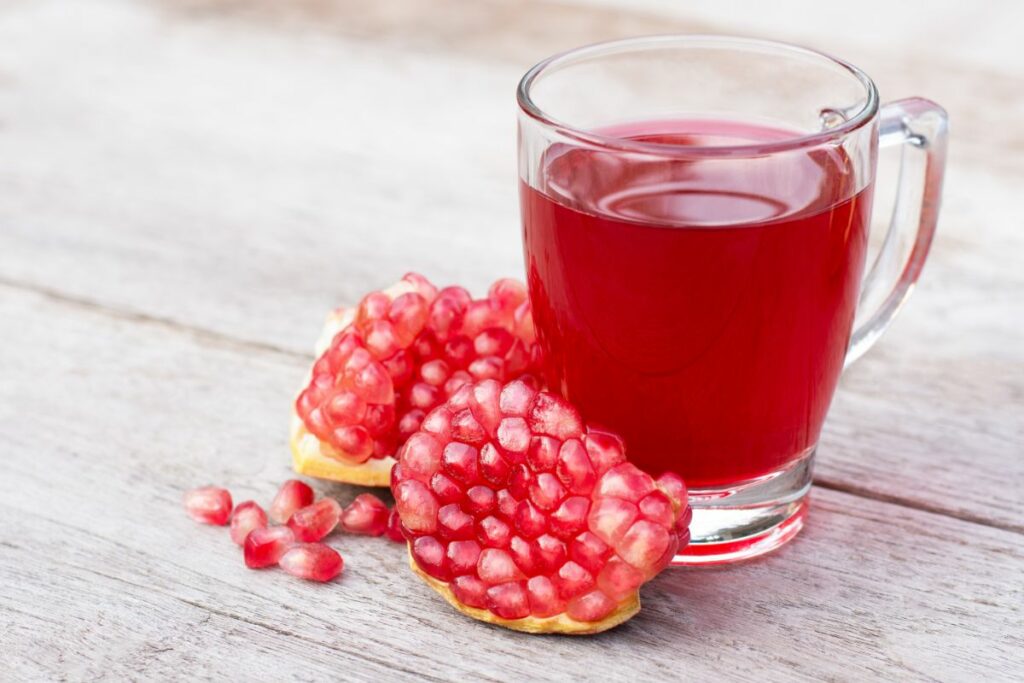When it comes to the world of fruit, the pomegranate has long been an underrated edition – one that until recently has skated beneath the surface in favor of more traditional fruits like apples and oranges.
However, pomegranates have made a resurgence in popularity in recent years, with their status as a ‘superfood’ granting them a certain level of prestige amongst the health conscious.
But what exactly is a pomegranate, and what are the proper ways to eat them?

What Is A Pomegranate?
The pomegranate is the fruit of the deciduous shrub of the same name that originally grew exclusively in the Mediterranean region – long being used within cuisine for centuries.
In the 16th century, the pomegranate was then introduced to Spanish America, and then California in 1769 – where it remains a popularly grown fruit.
What Does Pomegranate Taste Like?
When it comes to the taste of pomegranate, it could best be described as sweet and tart – with a texture that is both crunchy at first, and then pulpy afterwards.
This gives it a lot of versatility when it comes to cooking, baking, fermenting, and distilling – which explains why it has had so much widespread use throughout the world in a number of different ways.
What Is The Proper Way To Eat Them?
While the whole of the fruit can indeed be eaten once picked, the pomegranate skin is not usually the part that is consumed.
To ‘properly’ eat the pomegranate fruit, you need to set your focus on the sweet, juicy, red seeds inside, as this is where all the flavor is located.
As such, pomegranates are typically sliced into segments, after which the red seeds are then scooped or prised out using a spoon.
They can then be eaten as they are, or added to numerous dishes – including salads, fruit salads, and even cooked dishes.
What Are Pomegranates Used For?

Aside from being eaten straightforwardly as a piece of fruit, the pomegranate also has numerous other uses that have made it popular throughout the centuries.
For Juicing
One common use for pomegranate is as a form of fruit juice – with the seeds themselves being blitzed until they form a sweet and nutritious juice.
This is then usually combined with other fruits – such as oranges – to create a saleable fruit juice on consumer markets. However, it can also be consumed by itself without any other additions.
For Smoothies
Likewise, the seeds are also commonly incorporated into fruit smoothies, where they can be a great source of both color and sweetness.
In Salads
Pomegranate seeds can also be eaten as part of cold salads – alongside other seasonal vegetables, seeds, nuts, and additional ingredients.
This has become especially popular since they were recognized as a superfood, and many incorporate them into their salads as a means of taking advantage of the associated health benefits – as well as adding a little sweetness to their food.
For Alcohol Production
Due to their natural juiciness, flavor, and coloring, pomegranate seeds have long been used in the production of various forms of alcoholic beverages – including wines, mead, spirits, and in more recent times, cocktails.
For Garnishing
They have also long been used as a form of garnish – either on the side of a plate during a meal, or wrapped over the side of a cocktail glass to add a little interest and extravagance.
This is due to the bright colors of the seeds, and the somewhat rustic exterior – which when put together have a rather stylish appearance.
What Does The Term ‘Superfood’ Mean?
The term ‘superfood’ is actually a marketing term, used to describe foods that have purported health benefits. This is usually due to the high nutrient of the food in question, which can often lead to trends surrounding their sale and purchase.
The pomegranate is one such food that has been given this title, and this prestige is largely responsible for the rise in popularity that the fruit has seen in the past decade or so.
What Benefits Do Pomegranates Have?

As you might expect, to be given such a title, the pomegranate has to have many benefits to the consumer.
Loaded With Nutrients
While relatively high in calories and sugar, pomegranates are rich in protein, fiber, calcium, iron, magnesium, phosphorus, potassium, vitamin C, and Vitamin B9 (folate).
Rich In Antioxidants
They are also rich in antioxidants, which makes them good for slowing down the aging process, easing chronic illnesses, reducing cancer risks, and limiting the potential for severe illnesses.
Anti-inflammatory Properties
They are also thought to have distinct anti-inflammatory properties – making them good for chronic illnesses, internal inflammation, age-related mobility issues, and numerous other conditions.
Good For The Body
They are also good for brain development and maintenance (due to the presence of ellagitannins), beneficial for the heart (due to polyphenolic compounds), and supportive for the urinary system – due to the effect they have on kidney stones, and similar ailments.
Final Thoughts
It is certainly true that, despite being an underrated fruit for many years, the pomegranate is enjoying something of a renaissance in recent years – with its status as a superfood raising it to the heights of fruit royalty.
So if you are looking to try a new fruit, then why not give pomegranate a go?
Frequently Asked Questions
Now that we know a little more about pomegranates, and the right way to eat them, it is now time to answer some frequently asked questions that you might be interested in.
Unfortunately, pomegranates are indeed some of the most expensive fruits in the grocery store – something that comes from their prestige as a superfood, as well as their popularity.
While it is not common for people to eat the skin of the pomegranate, they are actually quite healthy in their own right – containing plenty of antioxidants and polyphenols.
- How To Reheat A Cheesesteak - November 5, 2023
- What Are Three Must Have Kitchen Knives? - September 22, 2023
- How To Protect Edges Of Pie Crust - June 15, 2023








